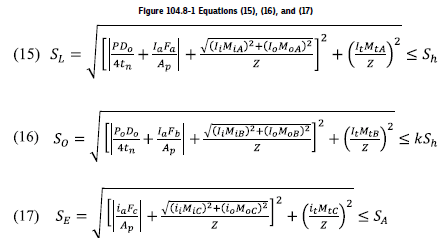Hi!
Does anyone know of a design code that deals with cross sectional capacity of pipe subjected to moment, tension and internal pressure?
Or know of any other references (with formula)?
For the sake of argument let's assume a catilever pipe with internal pressure and tension and horizontal force that produces a reaction moment.
So far I've been working under the assumption that the following would be conservative (ignoring shear):
M/Mcap + T/Tcap + P/Pcap < 1.0
Where:
M = (reaction) moment
Mcap = moment capacity of cross section
T = Tension
Tcap = Tension capacity of cross section
P = internal pressure
Pcap = Pressure capacity of cross section
Idealy I would plot moment capacity vs. tension capacity for a given pressure, but have not found a source that describes a relationship.
When dealing with internal pressure and external axail load is this where "Effective Tension" comes into play? (I'm not really familiar with this)
In advance, thank you
Regards
Siggi
Does anyone know of a design code that deals with cross sectional capacity of pipe subjected to moment, tension and internal pressure?
Or know of any other references (with formula)?
For the sake of argument let's assume a catilever pipe with internal pressure and tension and horizontal force that produces a reaction moment.
So far I've been working under the assumption that the following would be conservative (ignoring shear):
M/Mcap + T/Tcap + P/Pcap < 1.0
Where:
M = (reaction) moment
Mcap = moment capacity of cross section
T = Tension
Tcap = Tension capacity of cross section
P = internal pressure
Pcap = Pressure capacity of cross section
Idealy I would plot moment capacity vs. tension capacity for a given pressure, but have not found a source that describes a relationship.
When dealing with internal pressure and external axail load is this where "Effective Tension" comes into play? (I'm not really familiar with this)
In advance, thank you
Regards
Siggi

